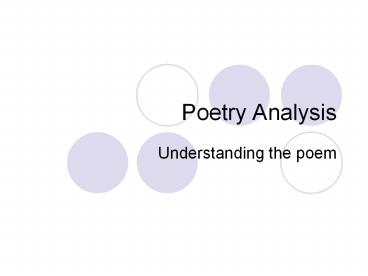Poetry Analysis - PowerPoint PPT Presentation
1 / 10
Title:
Poetry Analysis
Description:
Poetry Analysis Understanding the poem – PowerPoint PPT presentation
Number of Views:126
Avg rating:3.0/5.0
Title: Poetry Analysis
1
Poetry Analysis
- Understanding the poem
2
LINEATION AND STANZAS
- Line length in formal verse. Do the lines
appear to be about the same length, or are there
patterns of short and long lines organized in
stanzas? (In formal verse written in English,
line length is usually counted in units called
metrical feet. For instance, lines containing
five metrical feet are called pentameter lines.
Most sonnets contain 14 pentameter lines.) - Line length in a free verse poem. Do you
see patterns or modulation in line length? Do
lines get gradually longer or gradually shorter?
Does line length somehow correspond to the
content?
3
LINEATION AND STANZAS
- Line breaks. Why do the lines break where
they do? Be aware of how line breaks can
contribute to such artistic effects as rhythm,
energy, suspense, and ambiguity. - End-stopped and Enjambed lines. Count the number
of enjambed lines (lines without punctuation at
the end). Does the poem have more end-stopped
lines or more enjambed lines? This is related to
the poets decisions about line breaks. The
liberal use of enjambment creates a more open,
flowing feeling. - Stanzas. Do the stanzas contain a set number
of lines? Do they follow a pattern of longer and
shorter lines? Do they have any particular shape?
In a free verse poem, what function do the stanza
breaks (blank lines between the stanzas) serve?
4
Conventions of Meaning Diction, Figurative
Language, and Speech Acts
- Diction. Poetry can be written in high,
middle, and low diction. High diction is the most
elevated language. Low diction is the most
colloquial or common language. - Words and word families. Consider the
etymologies and connotations of words carefully.
Look for words related to each other by
etymology, sound, or appearance. Look up word
etymologies in the Oxford English Dictionary. - Figurative language. Consider the use of
figures of speech such as metaphor, simile,
oxymoron, synecdoche, metonymy, hyperbole,
allegory, etc. - Speech acts. A poem can be analyzed as a
sequence of speech acts. Speech acts are
particular forms of address such as apology,
exhortation, apostrophe, lament, etc.
5
Sound, Rhythm, and Repetition
- Words sound weight. Do you see sound
patterns such as alliteration, assonance, or
consonance? Be aware that all syllables are not
equal in weight some take longer to say than
others. Patterns in either sound or weight are
significant aspects of technique. - End rhyme and internal rhyme. End rhyme,
which is more common in formal verse than in free
verse, occurs when rhyming words appear at the
ends of lines. Look for patterns of end rhyme
such patterns are called the rhyme scheme.
Internal rhyme occurs when rhyming words appear
anywhere other than the ends of lines. - Slant rhyme (or near rhyme). Notice the
use of inexact rhymes. Such slant rhymes or
near rhymes do not stand out as much as exact
rhymes
6
Rhythm
- Meter (formal verse). The rhythm of formal verse
is more-or-less regular, and its pattern is
called meter. Do some research on the Internet
for tips on how to determine the meter and
analyze the rhythm of formal verse. - Rhythm (free verse). The rhythm of a free
verse poem is irregular, and for this reason it
is not possible to determine metrical feet
nevertheless, you can still mark the stresses or
hear more-or-less subtle rhythms. How does rhythm
serve the feeling and sense of the poem?
7
.and Repetition
- Punctuation. Is punctuation missing where
you expect it, or present in ways you dont
expect? Does the poet use line breaks to suggest
punctuation? Does punctuation tend to occur at
the ends of lines or in the middle of lines?
(This is related to the practice of enjambment.
See above.) - Repetition of words, phrases and lines.
Repetition can serve to enforcemore or less
subtly, depending on how obvious it isideas and
emotions. It is also an aspect of rhythm.
Repetition of words and phrases at the beginnings
of lines is called anaphora, and a poem composed
of a number of lines that all begin the same way
participates in a tradition the goes back to
ancient oratory, the Bible and the liturgy. - Repetition of Syntactical Structures. Look
at the sentences in the poem. Are they short,
long, or some combination? Do you see patterns in
sentence structure? Does the poet use a number of
rhetorical questions or antithetical statements,
for instance?
8
Visual Effects
- Graphic Format. Look at the poem on the
page. Notice its general shape, as well as the
shapes of the stanzas. Does the poet manipulate
the graphic or visual aspect of the poem with
unexpected capitalization, variations in font or
font-size, spacing, etc.? - Capitalization. Is capitalization missing
where you expect it (as in e.e. cummings poems),
or present where you wouldnt expect it? Be aware
of the ways in which unexpected capitalization
can shift the function of a word or make it
ambiguous.
9
Assignment
- Read your poem and complete the TPCASTT
- Use Facts on File or Gale to access at least one
literary criticism of the title and one biography
of the author. Cite your source in your power
point - Power point rubric will be uploaded by Wednesday
on the web site.
10
Where to Find?
- Facts on File and Gale
- Name is northwesths
- Password is Texans
- Login to blue lit book is
- http//my.hrw.com































